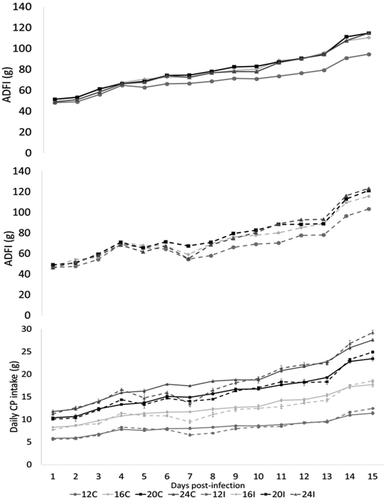Figures & data
Table 1. Effect of different levels of turmeric rhizome powder on haematochemical parameters of broiler chickens.
Table 1. The effects of the duration of collection period on N-corrected apparent metabolisable energy (AMEn), total tract dry matter (DMR), nitrogen (NR) and fat (FR) retention coefficients in broilers.
Table 1. Growth, cut parts and economics of diets of broilers fed blanched Anthonotha macrophylla seeds meal.
Table 1. Performance of chicks (0-6weeks) as influenced by the inclusion of Black Soldier Fly meal.
Table 1. Caeca weights and performance results.
Table 1. Comparison of bone strength in birds fed high and low phytase diets.
Table 1. Effect of RSM type (ST or M), Phytase (QB) and Xylanase (XYL) on feed intake (FI), weight gain (WG), feed conversion efficiency (FCE), N-corrected apparent metabolisable energy (AMEn), nitrogen (NR) and fat (FR) retention coefficients when fed to chickens from 7 to 21 days of age.
Table 1. The effect of additives with and without coccidian challenge on d21 BWG (g/bird), ileal flow of carbohydrate fractions (g/100g ileal digesta), caecal SCFA concentrations and the expression profile of immune-related genes.
Table 1. Digestion time and rate of starch digestion between different wheat-based dietsa.
Table 1. The effect of dietary phytase and myo-inositol (MI) supplementation on feed intake (FI), average daily gain (ADG), feed conversion ratio (FCR) from day 0–21 and concentration of MI in blood plasma of broiler chickens.
Table 1. Relative impact of AA supply on resilience (body weight gain (BWG) and feed efficiency (FE) under challenge).
Table 1. Relationship between wheat characteristics, growth and jejunal gene expression in broilers.
Figure 1. ADFI (g/d) over the post-infection period of uninfected (C) broilers (Figure 1a), or broilers infected with (I) 7 × 103 sporulated E. maxima oocysts (Figure 1b) fed one of four feeds differing in CP (d0-15pi). Figure 1c. CPI (g/d) over the post-infection period of C and I broilers fed one of four feeds differing in CP (d0-15pi).

Table 1. Broiler performance data post Salmonella exposure.
Table 1. Effects of phytogenics (Biostrong 510®) on growth performance and mortality of broilers placed on clean or re-used litter.
Table 1. Correlation (r) between production performance and egg quality parameters of ISA Brown hens (n= 45).
Table 1. The effect of wheat (ground and whole) with and without enzyme on layer performances.
Table 1. Effect of feeding program on various criteria of broiler chickens.
Table 1. Productive performance for two varieties of Japanese quail under high environmental temperature.
Table 2. Partial regression coefficients of factors affecting expected feed intake for two varieties of Japanese.
Table 1. Effect of dietary supplementation of ginger on antioxidant status and gut microbial population of broilers.
Table 1. Performance (0-42d), and gut morphometry of broiler chickens. Values with different superscript letters across columns are significant (P > 0.05).
Table 1. Performance data of turkey poults 0–21 and 0–42 days of age.
Table 2. Comparison of performance data between controls and poults receiving HDDP.
Table 1. The daily feed intake, weight gain and feed conversion efficiency (FCE), dietary apparent metabolisable energy (AME), AME intake and glutathione peroxidase (GPx) in blood of 28-day-old chickens fed the experimental diets.
Table 1. The effects of rearing temperature and supplementary Se sources on broilers feed intake (FI), weight gain (WG), feed conversion efficiency (FCE), Se in liver, total antioxidant status (TAS) and glutathione peroxidase (GSH-Px) in blood.
Table 1. MIC and MBC values for three phytogenics with greatest antibacterial activity against 20 isolates.
Table 1. Performance characteristics and serum mineral concentration of experimental laying chickens fed diet supplemented with Cu, Zn and Mn.
Table 1. The effect of sundried cassava peel meal supplemented with molasses on the growth performance and nutrients digestibility of Japanese quails as a substitute for maize.
Table 1. The effect of dietary xylanase on daily feed intake (FI), daily weight gain (WG), feed conversion ratio (FCR), apparent metabolisable energy (AME), dry matter retention (DMR) coefficient and the relative weight of the gastrointestinal tract of broiler chickens.
Table 1. Effects of fresh and re-used litter on growth performance, litter quality and caecal morphology.
Table 1. Susceptible phytic acid P content of feed ingredients from the UK (Morgan et al., Citation2016a,Citationb) and Australia (2018).
Table 1. Performance data from d0-21, body weight (BW), average daily gain (ADG) and feed conversion ratio (FCR).
Table 1. Effect of feed and challenge on chicken performance over 35-day period.
Figure 1. A histopathological view of liver (1) and kidney (2) tissues taken from broilers fed diets containing (A) 0 g/kg cyromazine, (B) 0.25 g/kg cyromazine, (C) 0.50 g/kg cyromazine and (D) 0.75 g/kg cyromazine. Arrows indicate necrosis of hepatocyte of the liver (A1-D1) and tubular necrosis and desquamation of kidney (A2-D2). Magnification x400.

